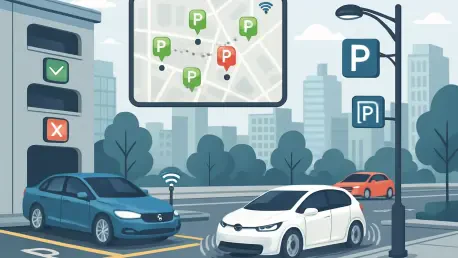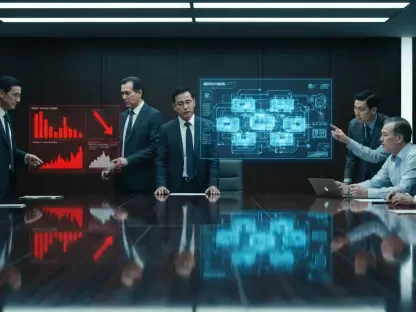Imagine driving through a bustling city center, circling block after block in search of an elusive parking spot, wasting time, fuel, and patience, only to find yourself frustrated. This frustrating scenario is a daily reality for millions of urban drivers, contributing to traffic congestion and environmental degradation. In response to this pervasive challenge, a groundbreaking technology has emerged from research labs, promising to transform how cities manage on-street parking. This review delves into an innovative solution known as Cord-Approx, a smart parking coordination system developed by cutting-edge researchers, which aims to slash search times and enhance urban livability through intelligent, data-driven strategies.
Understanding the Need for Smart Parking Solutions
Urban areas worldwide grapple with the inefficiencies of parking, where drivers often spend significant portions of their journeys hunting for available spots. This not only heightens driver stress but also exacerbates traffic bottlenecks, as vehicles idle or loop through crowded streets. The ripple effects extend to increased air pollution and wasted fuel, posing challenges to sustainability goals in densely populated regions.
Smart parking coordination systems have arisen as a technological antidote to these issues, leveraging data and algorithms to guide drivers efficiently to open spaces. Unlike traditional parking apps that merely predict availability, these systems introduce a layer of coordination to prevent multiple drivers from converging on the same spot. This shift from individualistic searches to a managed, cooperative approach marks a significant evolution in urban mobility technology.
The relevance of such innovations cannot be overstated, as cities strive to optimize curb space and integrate parking solutions into broader smart city frameworks. By addressing a seemingly mundane issue, these systems contribute to larger objectives like reducing greenhouse gas emissions and improving the quality of urban life. This sets the stage for a deeper exploration of a pioneering solution within this domain.
Core Innovations of Cord-Approx Technology
Data-Driven Parking Spot Assignment
At the heart of Cord-Approx lies its ability to assign specific parking spots to drivers using historical data and predictive algorithms. This method minimizes competition by ensuring that drivers are directed to distinct locations, avoiding the chaos of multiple vehicles targeting the same area. Simulations conducted in a major European city demonstrated a staggering 66% reduction in search time, with drivers locating spots in under 7 minutes compared to nearly 20 minutes without guidance.
This efficiency stems from the system’s sophisticated use of past parking patterns to forecast availability and match drivers accordingly. By analyzing success rates of previous assignments, the technology refines its predictions, ensuring optimal outcomes even with incomplete real-time data. Such precision highlights the potential for significant time savings on a city-wide scale.
Beyond individual benefits, this approach offers urban planners valuable insights into parking demand trends. Identifying high-demand zones through data analysis can inform infrastructure adjustments or policy measures, making the system a dual-purpose tool for both drivers and municipal authorities.
Seamless Navigation Platform Integration
Another standout feature of Cord-Approx is its compatibility with widely used navigation tools such as Google Maps and Waze, achieved through a dedicated API. This integration allows drivers to receive real-time parking guidance directly within familiar interfaces, lowering the barrier to adoption. Rather than requiring a standalone app, the system enhances existing platforms by adding a coordination layer that goes beyond basic availability forecasts.
Technically, this connection ensures that as drivers near their destinations, the system dynamically updates suggested parking locations based on current conditions and other users’ movements. This real-time adaptability is crucial for maintaining accuracy in dynamic urban environments where parking availability can change rapidly. The result is a smoother, more intuitive user experience that aligns with modern expectations of digital convenience.
The significance of this feature extends to scalability, as leveraging established platforms means the technology can reach a broader audience without necessitating widespread behavioral shifts. This strategic integration positions Cord-Approx as a practical enhancement to everyday navigation, paving the way for mass implementation in diverse urban settings.
Emerging Trends in Parking Technology
The landscape of parking solutions is evolving rapidly, with a noticeable pivot toward coordinated, data-centric systems like Cord-Approx. This trend reflects a broader recognition that individual, unguided searches are inefficient in crowded cities, prompting a move to city-wide management strategies. Such approaches prioritize collective efficiency over isolated predictions, marking a paradigm shift in how parking challenges are addressed.
Machine learning plays an increasingly central role in this evolution, enabling systems to refine their predictive capabilities through continuous data analysis. By learning from real-world patterns, these technologies can anticipate parking turnover and driver behavior with greater accuracy. This advancement underscores the potential for even more precise coordination in the coming years, as algorithms become more attuned to complex urban dynamics.
Additionally, municipal policies and consumer attitudes are beginning to align with these innovations, with cities exploring partnerships to test smart parking tools and drivers showing openness to tech-driven solutions. This growing acceptance, coupled with the push for sustainability, suggests that coordinated parking systems could soon become a standard component of urban infrastructure, reshaping how curb space is managed.
Urban Impact and Practical Applications
The practical implications of smart parking coordination are vividly illustrated through simulation results from a major metropolitan area, where Cord-Approx drastically cut down search times for participants. This reduction translates to less time spent circling streets, directly alleviating traffic congestion in high-density zones. For drivers, the immediate benefit is a less stressful experience, with journeys concluding more predictably and efficiently.
On a broader scale, the technology impacts city planning by providing actionable data on parking usage patterns. Municipalities can use this information to implement dynamic pricing models, adjusting rates based on demand to balance curb space allocation. Such strategies help prevent overcrowding in popular areas while encouraging turnover, optimizing the use of limited urban resources.
Unique applications also emerge, such as identifying underutilized parking zones for repurposing or infrastructure development. This versatility demonstrates that the system’s value extends beyond guiding drivers, offering a comprehensive tool for urban authorities to address multifaceted challenges. The potential to adapt these insights across different cities further amplifies the technology’s transformative reach.
Challenges in Bringing Coordination to Reality
Despite its promise, implementing a system like Cord-Approx faces several hurdles, particularly in transitioning from simulations to real-world environments. Scaling the technology requires robust infrastructure to handle vast amounts of data with precision, a task complicated by the variability of urban layouts and traffic conditions. Ensuring consistent accuracy across diverse settings remains a technical obstacle that demands ongoing refinement.
Regulatory and privacy concerns also pose significant barriers, as the system relies on collecting and processing driver data to function effectively. Striking a balance between utility and safeguarding personal information is critical to gaining public trust and meeting legal standards. Municipalities must navigate these issues carefully to facilitate adoption without compromising individual rights.
Market resistance and the need for collaboration with city officials add further complexity, as widespread implementation hinges on stakeholder buy-in. Current efforts to develop a prototype and initiate pilot programs with local governments represent vital steps toward overcoming these challenges. These initiatives aim to validate the system’s effectiveness in live scenarios, providing a foundation for addressing limitations through practical feedback.
Future Outlook for Smart Parking Coordination
Looking ahead, the trajectory of smart parking coordination systems appears promising, with Cord-Approx poised for significant advancements. Real-world testing, currently in the planning stages, will be crucial for refining the algorithm and adapting it to unpredictable variables like sudden traffic spikes or construction disruptions. These pilots, expected to roll out in select cities over the next few years, will provide critical data on the system’s performance under actual conditions.
Long-term, the technology holds the potential to redefine urban sustainability by curbing emissions tied to parking searches, a small but cumulative contributor to pollution. Enhanced traffic management through coordinated parking could also alleviate strain on city grids, fostering smoother flows and reducing bottlenecks. Such outcomes align with global priorities for greener, more livable urban spaces.
Beyond immediate impacts, the possibility of integrating this system with other smart city technologies—such as traffic light optimization or electric vehicle charging networks—offers a vision of interconnected urban ecosystems. As cities continue to evolve, solutions like Cord-Approx could serve as building blocks for comprehensive mobility frameworks, driving efficiency and convenience on an unprecedented scale.
Reflecting on the Path Forward
Reflecting on this evaluation, it is evident that Cord-Approx stands out as a pioneering force in tackling urban parking woes, with simulation outcomes showcasing a remarkable cut in search times. The technology’s ability to coordinate drivers and integrate with existing navigation tools marks a significant leap forward in addressing a longstanding urban challenge. Its broader contributions to traffic reduction and environmental benefits further underscore its value.
Moving beyond theoretical success, the actionable next step involves accelerating pilot programs in partnership with municipal bodies to test the system in real-world conditions. Collaborations with tech providers to enhance data accuracy and user interfaces are also essential to ensure seamless adoption. These efforts need to prioritize transparency in data handling to build public confidence and overcome privacy concerns.
Ultimately, the journey ahead requires a concerted push to scale this innovation across diverse urban landscapes, tailoring it to local needs while maintaining its core efficiency. Exploring synergies with other smart city initiatives offers a compelling avenue to amplify its impact, ensuring that parking coordination becomes a cornerstone of future urban planning. This path, if pursued diligently, promises to reshape how cities navigate the complexities of mobility and sustainability.









